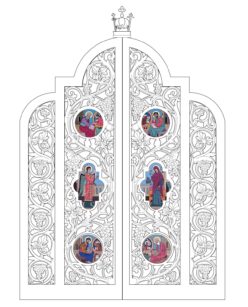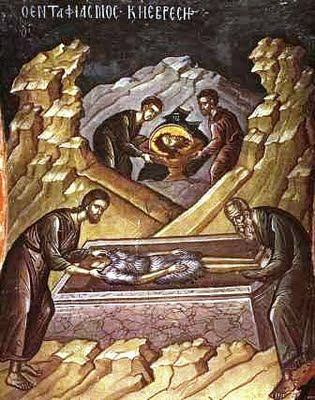The great and glorious Baptist John was beheaded according to the wish and instigation of the wicked Herodias, the wife of Herod. When John was beheaded, Herodias ordered that his head not be buried with his body for she feared that this awesome prophet, somehow, would resurrect. Therefore, she took his head and buried it deep in the ground in a secluded and dishonorable place. Her maidservant was Johanna, the wife of Chuza a courtier of Herod. The good and devout Johanna could not tolerate that the head of the Man of God remain in this dishonorable place. Secretly she unearthed it, removed it to Jerusalem and buried it on the Mount of Olives. Not knowing of this, King Herod, when he learned of Jesus and how He worked great miracles, became frightened and said: “This is John whom I beheaded; he has been raised from the dead” (St. Mark 16:16). After a considerable period of time, an eminent landowner believed in Christ, left his position and the vanity of the world and became a monk, taking the name, Innocent. As a monk, he took up abode on the Mount of Olives exactly in the place where the head of the Baptist was buried. Wanting to build himself a cell for himself, he dug deep and discovered an earthen vessel and in it a head, which was mysteriously revealed to him, to be the head of the Baptizer. He reverenced it and reburied it in the same spot. Later, according to God’s Providence, this miracle-working relic [The head of St. John] traveled from place to place, sunk into the darkness of forgetfulness and again was rediscovered. Finally, during the reign of the pious Empress Theodora, the mother of Michael and the wife of Theophilus and at the time of Patriarch Ignatius it was translated to Constantinople. Many miraculous healings occurred from the relic of the Forerunner [Precursor]. It is important and interesting to note that while he was still alive, “John did no miracles” (St. John 10:41), however, his relics have been endowed with miraculous power. (Prologue of Ohrid) Continue reading February 24, 2014 Cheesefare Monday The First and Second Finding of the Precious Head of the Holy, Glorious Prophet, Forerunner and Baptist John
Continue reading February 24, 2014 Cheesefare Monday The First and Second Finding of the Precious Head of the Holy, Glorious Prophet, Forerunner and Baptist John
Day: 18 January 2014
February 23, 2014 Sunday of the Last Judgment (Meatfare), Octoechos Tone 7 Holy Priest-Martyr Polycarp, Bishop of Smyrna
Polycarp, this great apostolic man, was born a pagan. St. John the Theologian converted him to the Faith of Christ and baptized him. In his childhood, Polycarp became an orphan and according to a vision in a dream Callista, a noble widow, took him as her own son, raised and educated him. From his childhood Polycarp was devout and compassionate. He strove to emulate the life of St. Bucolus, then the Bishop of Smyrna, as well as the holy Apostles John and Paul, whom he knew and heard. St. Bucolus ordained him a presbyter and before his death, Bucolus designated him as his successor in Smyrna. The apostolic bishops, who gathered at the funeral of Bucolus, consecrated Polycarp as bishop. From the very beginning, Polycarp was gifted with the power of working miracles. He expelled an evil spirit from the servant of a prince and through prayer stopped a terrible fire in Smyrna. Upon seeing this, many pagans regarded Polycarp as one of the gods. He brought down rain in times of drought, healed illnesses, discerned, prophesized and so forth. He suffered during the reign of Emperor Marcus Aurelius. Three days before his death, St. Polycarp prophesized: “In three days, I will be burned in fire for the sake of the Lord Jesus Christ!” And on the third day when the soldiers arrested him and brought him to trial, he cried out: “Let this be the will of the Lord my God.” When the judge counseled him to deny Christ and to acknowledge the Roman gods, Polycarp said: “I cannot exchange the better for the worse!” The Jews especially hated Polycarp and endeavored to have Polycarp burned alive. When they placed him bound at the stake, he prayed to God for a long while. He was very old, grey and radiant as an angel. The people witnessed how the flame encircled him but did not touch him. Frightened by such a phenomenon, the pagan judges ordered the executioner to pierce him with a lance through the fire. When he was pierced, so much blood flowed from him that the entire fire was extinguished, and his body remained whole and unburned. At the persuasion of the Jews, the judge ordered Polycarp’s lifeless body be incinerated according to the custom of the Hellenes. So the evil ones burned the dead body of the lifeless one whom they could not burn while alive. St. Polycarp suffered on Great and Holy Saturday in the year 167 A.D. (Prologue of Ohrid) Continue reading February 23, 2014 Sunday of the Last Judgment (Meatfare), Octoechos Tone 7 Holy Priest-Martyr Polycarp, Bishop of Smyrna
Continue reading February 23, 2014 Sunday of the Last Judgment (Meatfare), Octoechos Tone 7 Holy Priest-Martyr Polycarp, Bishop of Smyrna


